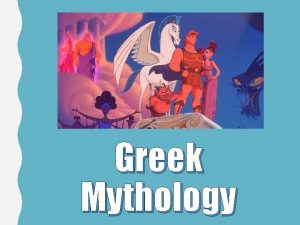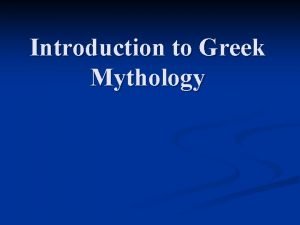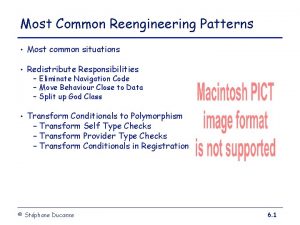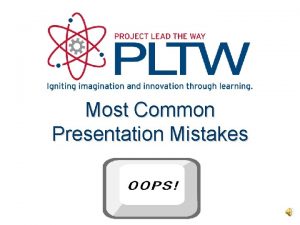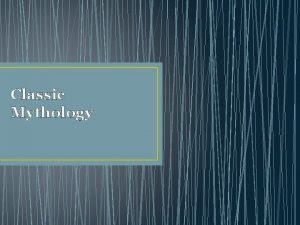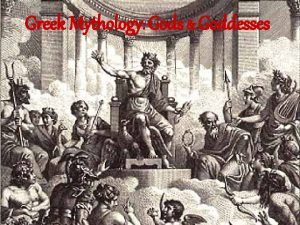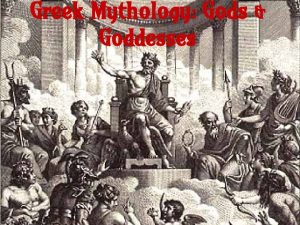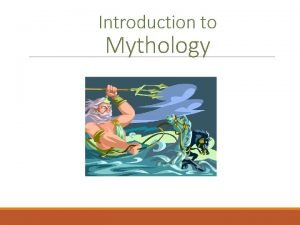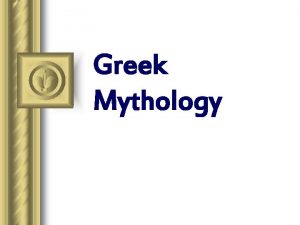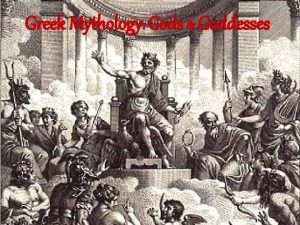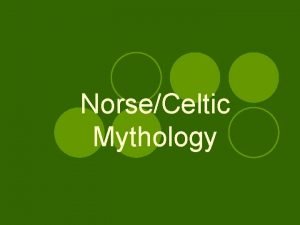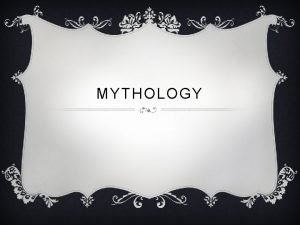Chapter 2 MYTHOLOGY Mythology The most common mythology


































- Slides: 34

Chapter 2 MYTHOLOGY

Mythology � The most common mythology people think of is Greek: � https: //www. youtube. com/watch? v=e. JC m 8 W 5 RZes

Introduction � But mythology is actually a broader term � Myths are religious narratives that tell stories and are important to religious beliefs �Origins �Histories �Rules of behavior �Can be written or oral

Myths and Worldview � All people experience things they can’t explain � The way we perceive reality is our worldview and it colors all we see and how we interact with things � Ex. Navaho vs. Judeo-Christian view of nature

Myths and Worldview � Read the Judeo-Christian and Navaho creation myths on pg. 34 -35 & pg. 45 -46 � Analyze for themes: �Nature-human interaction �How humans are created �View of animals �Interaction between humans and supernatural �Element of time

Myths and Worldview � So how would we summarize the different worldviews from these two creation myths?

Myths and Worldview Navaho: interconnectedness with nature, living in balance, respecting living things � Judeo-Christian: controlling nature, humans were given the world and can exploit it �

Supernatural Read the story on Snow White (pg. 3031) � What is the ‘moral’ of the story? � What aspects are supernatural? � Is this a religious study? Why or why not? �

Supernatural This story is a folktale � It entertains and gives a lesson, but is not a religious text �

Supernatural � Legends are stories that people believe really happened, but have been embellished � Urban legends are stories that supposedly happened in the recent past

Supernatural � What are some examples of urban legends?

Supernatural � Bloody Mary � Big Foot � The escaped killer with a hook hand � Basically anything that people think is a hoax or tabloid story

Myths These are sacred stories � They explain: � �Human’s origin �Creation of the universe �Values and norms �Good vs. evil They are religious and used in religious rituals � Bible stories, Qur’an, Torah, etc. � (Table 2. 1, pg. 32) �

Myths � Be able to distinguish what makes folktales, legends, and myths different � Use table in book

Written and Oral Texts � Some cultures do not have written histories �They use oral traditions to pass down cultural knowledge �Oral texts are performed, not recited �Slightly altered each generation �Can be adapted to new events � Others are written �Qur’an means “recitation” and is literal word of God and so not changed in any way

Example � Genesis from the Bible is a creation myth � Part 1: �God makes the world in 6 days �He makes plants, then animals, then humans �Importance of the Sabbath � Part 2: �Creates Adam and Eve �Fall from Eden �Makes humans first and then animals �Creates Eve out of Adam

Example � These myths reflect worldview and social charter (human interactions) �Male dominance �Humans given control over nature �Correct and incorrect behavior �Punishments

Myths � There are different forms of written traditions � How many versions of the Bible are there? � Some keep traditional language (it sounds more “religious”) and some use current language

Understanding Myths � Myths are found in all societies but vary widely � There are different ways to approach studying them �Most of these are connected to theories we discussed in chapter 1

Approaches to Myths � 1. Evolutionary �(incorrect) idea of unilineal evolution �Evolve from simple to complex �Primitive to civilized �Frazer (The Golden Bough) NO!

Approaches to Myths � 2. Fieldwork and Functional �Can use myths to understand cultural system �See what function myths have in society �Boas (Father of American Anthropology) �Malinowski (Essential needs of humans)

Approaches to Myths � 3. Structural �Look at structure of the myth �Dualism: light/dark, good/evil, male/female �No focus on meaning or content �Levi-Strauss

Approaches to Myths � 4. Psychological �Unconscious projections �Collective consciousness �Archetypes: orphan, creator, fool, etc. �Freud �Jung

Common Themes � Know common themes to use on homework!!

Common Themes Common themes may come from diffusion of knowledge or from collective consciousness � Birth Metaphor � �Supernatural creating something � Chaos �Things created out of chaos or darkness � Emergence �Things created by emerging from under the earth � Holy People �Holy beings create people

Apocalyptic Myths Center on the destruction of the world � Cycles of destruction and creation � � Noah’s flood � Revelations ○ Four horsemen, lamb of God, lake of fire, etc.

Trickster Myths � Some myths are for entertainment and some discuss serious matters � Trickster myths are less serious and teach people how not to behave � Example: Haida story of the Raven (pg. 49).

Hero Myths � Though stories all vary, there is a common pattern or story line (monomyth) � Hero leaves common world and enters supernatural world receives training encounters obstacles and is victorious hero returns to help his friends and family � Common in our stories and movies


Discussion Questions � 1. Define what worldview is. How does this impact how people see nature and the environment? � 2. What are some common themes among different religious creation myths? � 3. What is a monomyth? Why are popular movies (previous slide) not considered religious?

Assignment � ICA #1 “Creation Myths” together in groups

Videos � As you watch videos look for: �Similarities �Common themes �Connection to environment �Examples from lecture

Videos Egypt: http: //www. youtube. com/watch? v=u. Ty 49 Jlg. JZE � Inca: http: //www. youtube. com/watch? v=75 k. Db 2 Oq. BWI&list=PL 32257 EC AC 08445 A 3 � Aboriginal: http: //www. youtube. com/watch? v=koxp_q 46 z 0 Q&list=PL 32257 ECA C 08445 A 3 � Japan: http: //www. youtube. com/watch? v=PIQ 9 Ea 7 WDSI&list=PL 32257 EC AC 08445 A 3 �

Greek Mythology Video � http: //www. youtube. com/watch? v=c. QN 1 v. Gm. Hxs 4
 Factors of 18
Factors of 18 Common anode and common cathode
Common anode and common cathode Factor tree of 56
Factor tree of 56 Factors of 54
Factors of 54 Lcm of 10 and 18
Lcm of 10 and 18 Multiples of 9 and 21
Multiples of 9 and 21 Hình ảnh bộ gõ cơ thể búng tay
Hình ảnh bộ gõ cơ thể búng tay Lp html
Lp html Bổ thể
Bổ thể Tỉ lệ cơ thể trẻ em
Tỉ lệ cơ thể trẻ em Gấu đi như thế nào
Gấu đi như thế nào Thang điểm glasgow
Thang điểm glasgow Hát lên người ơi alleluia
Hát lên người ơi alleluia Kể tên các môn thể thao
Kể tên các môn thể thao Thế nào là hệ số cao nhất
Thế nào là hệ số cao nhất Các châu lục và đại dương trên thế giới
Các châu lục và đại dương trên thế giới Cong thức tính động năng
Cong thức tính động năng Trời xanh đây là của chúng ta thể thơ
Trời xanh đây là của chúng ta thể thơ Mật thư tọa độ 5x5
Mật thư tọa độ 5x5 101012 bằng
101012 bằng độ dài liên kết
độ dài liên kết Các châu lục và đại dương trên thế giới
Các châu lục và đại dương trên thế giới Thơ thất ngôn tứ tuyệt đường luật
Thơ thất ngôn tứ tuyệt đường luật Quá trình desamine hóa có thể tạo ra
Quá trình desamine hóa có thể tạo ra Một số thể thơ truyền thống
Một số thể thơ truyền thống Bàn tay mà dây bẩn
Bàn tay mà dây bẩn Vẽ hình chiếu vuông góc của vật thể sau
Vẽ hình chiếu vuông góc của vật thể sau Thế nào là sự mỏi cơ
Thế nào là sự mỏi cơ đặc điểm cơ thể của người tối cổ
đặc điểm cơ thể của người tối cổ Thế nào là giọng cùng tên? *
Thế nào là giọng cùng tên? * Vẽ hình chiếu đứng bằng cạnh của vật thể
Vẽ hình chiếu đứng bằng cạnh của vật thể Fecboak
Fecboak Thẻ vin
Thẻ vin đại từ thay thế
đại từ thay thế điện thế nghỉ
điện thế nghỉ




































